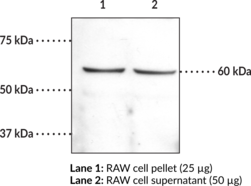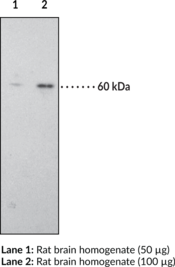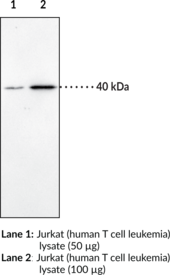Cayman
Showing 14251–14400 of 45550 results
-
CB-1954 is a prodrug that is enzymatically activated to generate an antitumor agent that forms DNA-DNA interstrand crosslinks.{33004} In rat Walker 256 carcinoma cells, CB-1954 is reduced by NAD(P)H:quinone oxidoreductase (NQO1) to the cytotoxic derivative 5-(aziridin-1-yl)-4-hydroxylamineo 2 nitrobenzamide, a bifunctional alkylating agent.{33004}
Brand:CaymanSKU:21023 -Out of stock
CB-1954 is a prodrug that is enzymatically activated to generate an antitumor agent that forms DNA-DNA interstrand crosslinks.{33004} In rat Walker 256 carcinoma cells, CB-1954 is reduced by NAD(P)H:quinone oxidoreductase (NQO1) to the cytotoxic derivative 5-(aziridin-1-yl)-4-hydroxylamineo 2 nitrobenzamide, a bifunctional alkylating agent.{33004}
Brand:CaymanSKU:21023 -Out of stock
CB-25 is a stable analog of Δ9-tetrahydrocannabinol (THC) and anandamide (AEA). It exhibits high affinity for the central cannabinoid (CB1) and peripheral cannabinoid (CB2) receptors with Ki values of 5.2 and 13 nM, respectively. CB-25 behaves as an inverse agonist for the CB1 receptor as assessed in a cyclic AMP (cAMP) functional assay.{14815,14816}
Brand:CaymanSKU:10010116 - 1 mgAvailable on backorder
CB-25 is a stable analog of Δ9-tetrahydrocannabinol (THC) and anandamide (AEA). It exhibits high affinity for the central cannabinoid (CB1) and peripheral cannabinoid (CB2) receptors with Ki values of 5.2 and 13 nM, respectively. CB-25 behaves as an inverse agonist for the CB1 receptor as assessed in a cyclic AMP (cAMP) functional assay.{14815,14816}
Brand:CaymanSKU:10010116 - 10 mgAvailable on backorder
CB-25 is a stable analog of Δ9-tetrahydrocannabinol (THC) and anandamide (AEA). It exhibits high affinity for the central cannabinoid (CB1) and peripheral cannabinoid (CB2) receptors with Ki values of 5.2 and 13 nM, respectively. CB-25 behaves as an inverse agonist for the CB1 receptor as assessed in a cyclic AMP (cAMP) functional assay.{14815,14816}
Brand:CaymanSKU:10010116 - 5 mgAvailable on backorder
CB-5083 is an orally bioavailable inhibitor of p97 (IC50 = 11 nM), a transitional endoplasmic reticulum ATPase also known as valosin-containing protein (VCP).{32505,32506} It disrupts cellular protein homeostasis and demonstrates anti-tumor activity in hematological and solid tumor models. CB-5083 causes accumulation of poly-ubiquitinated proteins, retention of endoplasmic reticulum-associated degradation (ERAD) substrates, and activation of the apoptotic arm of the unfolded protein response.{32505,32506}
Brand:CaymanSKU:-Available on backorder
CB-5083 is an orally bioavailable inhibitor of p97 (IC50 = 11 nM), a transitional endoplasmic reticulum ATPase also known as valosin-containing protein (VCP).{32505,32506} It disrupts cellular protein homeostasis and demonstrates anti-tumor activity in hematological and solid tumor models. CB-5083 causes accumulation of poly-ubiquitinated proteins, retention of endoplasmic reticulum-associated degradation (ERAD) substrates, and activation of the apoptotic arm of the unfolded protein response.{32505,32506}
Brand:CaymanSKU:-Available on backorder
CB-5083 is an orally bioavailable inhibitor of p97 (IC50 = 11 nM), a transitional endoplasmic reticulum ATPase also known as valosin-containing protein (VCP).{32505,32506} It disrupts cellular protein homeostasis and demonstrates anti-tumor activity in hematological and solid tumor models. CB-5083 causes accumulation of poly-ubiquitinated proteins, retention of endoplasmic reticulum-associated degradation (ERAD) substrates, and activation of the apoptotic arm of the unfolded protein response.{32505,32506}
Brand:CaymanSKU:-Available on backorder
CB-5083 is an orally bioavailable inhibitor of p97 (IC50 = 11 nM), a transitional endoplasmic reticulum ATPase also known as valosin-containing protein (VCP).{32505,32506} It disrupts cellular protein homeostasis and demonstrates anti-tumor activity in hematological and solid tumor models. CB-5083 causes accumulation of poly-ubiquitinated proteins, retention of endoplasmic reticulum-associated degradation (ERAD) substrates, and activation of the apoptotic arm of the unfolded protein response.{32505,32506}
Brand:CaymanSKU:-Available on backorder
CB-52 is a stable analog of Δ9-tetrahydrocannabinol (THC) and anandamide (AEA). It exhibits high affinity for the central cannabinoid (CB1) and peripheral cannabinoid (CB2) receptors with Ki values of 210 and 30 nM, respectively.{14815} In vitro, CB-52 behaves primarily as a CB1 receptor partial agonist and a CB2 receptor neutral antagonist.{14816}
Brand:CaymanSKU:10010117 - 1 mgAvailable on backorder
CB-52 is a stable analog of Δ9-tetrahydrocannabinol (THC) and anandamide (AEA). It exhibits high affinity for the central cannabinoid (CB1) and peripheral cannabinoid (CB2) receptors with Ki values of 210 and 30 nM, respectively.{14815} In vitro, CB-52 behaves primarily as a CB1 receptor partial agonist and a CB2 receptor neutral antagonist.{14816}
Brand:CaymanSKU:10010117 - 10 mgAvailable on backorder
CB-52 is a stable analog of Δ9-tetrahydrocannabinol (THC) and anandamide (AEA). It exhibits high affinity for the central cannabinoid (CB1) and peripheral cannabinoid (CB2) receptors with Ki values of 210 and 30 nM, respectively.{14815} In vitro, CB-52 behaves primarily as a CB1 receptor partial agonist and a CB2 receptor neutral antagonist.{14816}
Brand:CaymanSKU:10010117 - 5 mgAvailable on backorder
CB-52 is a stable analog of Δ9-tetrahydrocannabinol (THC) and anandamide (AEA). It exhibits high affinity for the central cannabinoid (CB1) and peripheral cannabinoid (CB2) receptors with Ki values of 210 and 30 nM, respectively.{14815} In vitro, CB-52 behaves primarily as a CB1 receptor partial agonist and a CB2 receptor neutral antagonist.{14816}
Brand:CaymanSKU:10010117 - 50 mgAvailable on backorder
CB-7921220 is an inhibitor of the adenylyl cyclase (AC) isoforms AC1 and AC6.{38294} It is selective, reducing AC1 and AC6 activity by 60% while having no effect on AC2 and AC5 in Sf9 membranes stimulated by forskolin (Item No. 11018) when used at a concentration of 100 μM.
Brand:CaymanSKU:23332 - 1 mgAvailable on backorder
CB-7921220 is an inhibitor of the adenylyl cyclase (AC) isoforms AC1 and AC6.{38294} It is selective, reducing AC1 and AC6 activity by 60% while having no effect on AC2 and AC5 in Sf9 membranes stimulated by forskolin (Item No. 11018) when used at a concentration of 100 μM.
Brand:CaymanSKU:23332 - 10 mgAvailable on backorder
CB-7921220 is an inhibitor of the adenylyl cyclase (AC) isoforms AC1 and AC6.{38294} It is selective, reducing AC1 and AC6 activity by 60% while having no effect on AC2 and AC5 in Sf9 membranes stimulated by forskolin (Item No. 11018) when used at a concentration of 100 μM.
Brand:CaymanSKU:23332 - 25 mgAvailable on backorder
CB-7921220 is an inhibitor of the adenylyl cyclase (AC) isoforms AC1 and AC6.{38294} It is selective, reducing AC1 and AC6 activity by 60% while having no effect on AC2 and AC5 in Sf9 membranes stimulated by forskolin (Item No. 11018) when used at a concentration of 100 μM.
Brand:CaymanSKU:23332 - 5 mgAvailable on backorder
CB-839 is an orally bioavailable noncompetitive inhibitor of the glutaminase 1 (GLS1) splice variants, kidney-type (KGA) and glutaminase C (GAC), which convert glutamine into glutamate.{35064} CB-839 inhibits human recombinant GAC with IC50 values of less than 50 nM, varying based on the length of preincubation. It inhibits GLS1 activity in tissue homogenates (IC50s = 28 and 23 nM, respectively for brain and kidney), but it does not inhibit GLS2 (IC50 > 1,000 nM for liver). It possesses antiproliferative activity against the triple-negative breast cancer (TNBC) cell lines HCC1806 and MDA-MB-231 (IC50s = 49 and 26 nM, respectively) but not against estrogen receptor-positive T47D cells (IC50 > 1,000 nM). In a patient-derived TNBC mouse xenograft model, CB-839 (200 mg/kg, p.o.) inhibits tumor growth by 61% relative to vehicle control. It also possesses antiproliferative properties in vitro against acute myeloid leukemia (AML) and in synergy with erlotinib (Item No. 10483) in EGFR-driven non-small cell lung cancer (NSCLC) in vitro and in xenografts.{35065,35066,35067}
Brand:CaymanSKU:22038 -Out of stock
CB-839 is an orally bioavailable noncompetitive inhibitor of the glutaminase 1 (GLS1) splice variants, kidney-type (KGA) and glutaminase C (GAC), which convert glutamine into glutamate.{35064} CB-839 inhibits human recombinant GAC with IC50 values of less than 50 nM, varying based on the length of preincubation. It inhibits GLS1 activity in tissue homogenates (IC50s = 28 and 23 nM, respectively for brain and kidney), but it does not inhibit GLS2 (IC50 > 1,000 nM for liver). It possesses antiproliferative activity against the triple-negative breast cancer (TNBC) cell lines HCC1806 and MDA-MB-231 (IC50s = 49 and 26 nM, respectively) but not against estrogen receptor-positive T47D cells (IC50 > 1,000 nM). In a patient-derived TNBC mouse xenograft model, CB-839 (200 mg/kg, p.o.) inhibits tumor growth by 61% relative to vehicle control. It also possesses antiproliferative properties in vitro against acute myeloid leukemia (AML) and in synergy with erlotinib (Item No. 10483) in EGFR-driven non-small cell lung cancer (NSCLC) in vitro and in xenografts.{35065,35066,35067}
Brand:CaymanSKU:22038 -Out of stock
CB-839 is an orally bioavailable noncompetitive inhibitor of the glutaminase 1 (GLS1) splice variants, kidney-type (KGA) and glutaminase C (GAC), which convert glutamine into glutamate.{35064} CB-839 inhibits human recombinant GAC with IC50 values of less than 50 nM, varying based on the length of preincubation. It inhibits GLS1 activity in tissue homogenates (IC50s = 28 and 23 nM, respectively for brain and kidney), but it does not inhibit GLS2 (IC50 > 1,000 nM for liver). It possesses antiproliferative activity against the triple-negative breast cancer (TNBC) cell lines HCC1806 and MDA-MB-231 (IC50s = 49 and 26 nM, respectively) but not against estrogen receptor-positive T47D cells (IC50 > 1,000 nM). In a patient-derived TNBC mouse xenograft model, CB-839 (200 mg/kg, p.o.) inhibits tumor growth by 61% relative to vehicle control. It also possesses antiproliferative properties in vitro against acute myeloid leukemia (AML) and in synergy with erlotinib (Item No. 10483) in EGFR-driven non-small cell lung cancer (NSCLC) in vitro and in xenografts.{35065,35066,35067}
Brand:CaymanSKU:22038 -Out of stock
CB-839 is an orally bioavailable noncompetitive inhibitor of the glutaminase 1 (GLS1) splice variants, kidney-type (KGA) and glutaminase C (GAC), which convert glutamine into glutamate.{35064} CB-839 inhibits human recombinant GAC with IC50 values of less than 50 nM, varying based on the length of preincubation. It inhibits GLS1 activity in tissue homogenates (IC50s = 28 and 23 nM, respectively for brain and kidney), but it does not inhibit GLS2 (IC50 > 1,000 nM for liver). It possesses antiproliferative activity against the triple-negative breast cancer (TNBC) cell lines HCC1806 and MDA-MB-231 (IC50s = 49 and 26 nM, respectively) but not against estrogen receptor-positive T47D cells (IC50 > 1,000 nM). In a patient-derived TNBC mouse xenograft model, CB-839 (200 mg/kg, p.o.) inhibits tumor growth by 61% relative to vehicle control. It also possesses antiproliferative properties in vitro against acute myeloid leukemia (AML) and in synergy with erlotinib (Item No. 10483) in EGFR-driven non-small cell lung cancer (NSCLC) in vitro and in xenografts.{35065,35066,35067}
Brand:CaymanSKU:22038 -Out of stock
CB-86 is a resorcinol-anandamide hybrid compound that acts as a partial agonist for the central cannabinoid (CB1) receptor and a neutral antagonist for the peripheral cannabinoid (CB2) receptor with Ki values of 5.6 and 7.9 nM, respectively.{18014} Its demonstrated potency is similar to that of WIN 55,212-2 (Ki = 21 and 2.1 nM for CB1 and CB2, respectively).{18014} CB-86 (1 mg/kg) exhibits antinociceptive effects in mice treated with formalin.{18014}
Brand:CaymanSKU:-CB-86 is a resorcinol-anandamide hybrid compound that acts as a partial agonist for the central cannabinoid (CB1) receptor and a neutral antagonist for the peripheral cannabinoid (CB2) receptor with Ki values of 5.6 and 7.9 nM, respectively.{18014} Its demonstrated potency is similar to that of WIN 55,212-2 (Ki = 21 and 2.1 nM for CB1 and CB2, respectively).{18014} CB-86 (1 mg/kg) exhibits antinociceptive effects in mice treated with formalin.{18014}
Brand:CaymanSKU:-CB-86 is a resorcinol-anandamide hybrid compound that acts as a partial agonist for the central cannabinoid (CB1) receptor and a neutral antagonist for the peripheral cannabinoid (CB2) receptor with Ki values of 5.6 and 7.9 nM, respectively.{18014} Its demonstrated potency is similar to that of WIN 55,212-2 (Ki = 21 and 2.1 nM for CB1 and CB2, respectively).{18014} CB-86 (1 mg/kg) exhibits antinociceptive effects in mice treated with formalin.{18014}
Brand:CaymanSKU:-CB-86 is a resorcinol-anandamide hybrid compound that acts as a partial agonist for the central cannabinoid (CB1) receptor and a neutral antagonist for the peripheral cannabinoid (CB2) receptor with Ki values of 5.6 and 7.9 nM, respectively.{18014} Its demonstrated potency is similar to that of WIN 55,212-2 (Ki = 21 and 2.1 nM for CB1 and CB2, respectively).{18014} CB-86 (1 mg/kg) exhibits antinociceptive effects in mice treated with formalin.{18014}
Brand:CaymanSKU:-Immunogen: Synthetic peptide from the C-terminal region of human protein CB1 receptor • Host: rabbit • Species Reactivity: (+) human, mouse, and rat CB1 receptor • Application(s): IHC and WB • This antibody has been raised against the C-terminal (amino acids 461-472) intracellular region of the human CB1 receptor, a GPCR that binds the active component of cannabis, D9-tetrahydrocannabinol
Brand:CaymanSKU:10006590- 1 eaAvailable on backorder
Immunogen: Synthetic peptide from the C-terminal region of human protein CB1 receptor • Host: rabbit • Species Reactivity: (+) human, mouse, and rat CB1 receptor • Application(s): IHC and WB • This antibody has been raised against the C-terminal (amino acids 461-472) intracellular region of the human CB1 receptor, a GPCR that binds the active component of cannabis, D9-tetrahydrocannabinol
Brand:CaymanSKU:10006590- 1 eaThe CB1 receptor is a G-protein coupled receptor that binds the active component of cannabis, Δ9-tetrahydrocannabinol. This antibody has been raised against the C-terminal (amino acids 461-472) intracellular region of the human CB1 receptor and can be used for western blotting.{6749,6747} Human and rat CB1 receptors exhibit 97.3% homology at the amino acid level over the complete protein, and 100% homology within the peptide sequence used to make this antibody.{6629,6628} This peptide exhibits no homology with the CB2 receptor. Based on the amino acid sequence, the CB1 receptor has a molecular weight of approximately 52,800.{6628} The CB1 receptor and the splice variant CB1a are localized mainly in the brain, whereas the CB2 receptor is localized predominantly in peripheral tissues, including the spleen and hemopoietic cells.{6629,6628,6726,6727}
Brand:CaymanSKU:10006590 - 1 eaAvailable on backorder
Immunogen: Synthetic peptide from the N-terminal extracellular region of human CB1 receptor • Species Reactivity: (+) Human, mouse, and rat • Host: Rabbit • Applications: WB and IHC
Brand:CaymanSKU:101500- 1 eaThe CB1 receptor and the splice variant CB1a are localized mainly in the brain.{6628,6726,6724} The CB1 receptor is a G-protein coupled receptor that binds the active component of cannabis, Δ9-tetrahydrocannabinol. Human and rat CB1 receptors exhibit 97.3% homology at the amino acid level over the complete protein, and 100% homology within the peptide sequence used to make this antibody.{6629,6628} This peptide exhibits no homology with the CB2 receptor. Based on the amino acid sequence, the CB1 receptor has a molecular weight of approximately 52,800.{6628} The CB1 receptor and the splice variant CB1a are localized mainly in the brain, whereas the CB2 receptor is localized predominantly in peripheral tissues, including the spleen and hemopoietic cells.{6629,6628,6726,6724} Cayman’s CB1 Receptor Polyclonal Antibody can be used for Western blot and immunohistochemistry applications. The antibody recognizes the N-terminal extracellular region of the CB1 receptor at 40 kDa from human samples.
Brand:CaymanSKU:101500 - 1 eaAvailable on backorder
Immunogen: Synthetic peptide from the N-terminal extracellular region of human CB1 receptor • Species Reactivity: (+) Human, mouse, and rat • Host: Rabbit • Applications: WB and IHC
Brand:CaymanSKU:101500- 1 eaAvailable on backorder
Immunogen: Synthetic peptide from the N-terminal region of human CB2 receptor • Host: Rabbit • Species Reactivity: (+) Human and mouse • Cross Reactivity: (+) CB2 receptor • Applications: IHC and WB
Brand:CaymanSKU:101550- 1 eaThe CB2 receptor is localized predominantly in peripheral tissues, including the spleen and hemopoietic cells.{6724} · The CB1 and CB2 receptors are G-protein coupled receptors that bind the active component of cannabis, Δ9-tetrahydrocannabinol, as well as anandamide which is an endogenous CB receptor ligand. This antibody has been raised against a sequence between the N-terminus and the first transmembrane domain of the protein of the human CB2 receptor.{6724} It can be used for western blotting and immunohistochemistry applications. Conserved amino acids between the CB1 and CB2 receptors in this region are minimal.{6727} Human and murine CB2 receptors exhibit 82% homology at the amino acid level over the complete protein.{6727} The CB2 receptor is localized predominantly in peripheral tissues, including the spleen and hemopoietic cells.{6724}
Brand:CaymanSKU:101550 - 1 eaAvailable on backorder
Immunogen: Synthetic peptide from the N-terminal region of human CB2 receptor • Host: Rabbit • Species Reactivity: (+) Human and mouse • Cross Reactivity: (+) CB2 receptor • Applications: IHC and WB
Brand:CaymanSKU:101550- 1 eaAvailable on backorder
Immunogen: Synthetic peptide from the N-terminal region of human CB2 receptor • Host: Rabbit • Species Reactivity: (+) Human • Applications: FC and IF
Brand:CaymanSKU:10010712- 500 µlThe central cannabinoid (CB1) and peripheral cannabinoid (CB2) receptors are G protein-coupled receptors (GPCRs) that bind the active component of cannabis, Δ9-tetrahydrocannabinol, as well as anandamide which is an endogenous CB receptor ligand. This antibody has been raised against a sequence between the N-terminal and the first transmembrane domain of the protein of the human CB2 receptor.{6724} Conserved amino acids between the CB1 and CB2 receptors in this region are minimal.{6727} Human and mouse CB2 receptors exhibit 82% homology at the amino acid level over the complete protein.{6727} The CB2 receptor is localized predominantly in peripheral tissues, including the spleen and hemopoietic cells.{6724}
Brand:CaymanSKU:10010712 - 500 µlAvailable on backorder
Immunogen: Synthetic peptide from the N-terminal region of human CB2 receptor • Host: Rabbit • Species Reactivity: (+) Human • Applications: FC and IF
Brand:CaymanSKU:10010712- 500 µlAvailable on backorder
CBDB (Item No. 29031) is an analytical reference standard categorized as a phytocannabinoid.{50945} CBDB has been found in strains of cannabis and hemp.{50945,50420} CBDB is considered an impurity in commercial extractions of cannabidiol (CBD) from hemp.{50420} This product is intended for research and forensic applications. This item has been tested to contain ≤0.3% Δ9-THC on a dry weight basis meeting the 2018 Farm Bill requirements to be a non-controlled substance in the US.
Brand:CaymanSKU:29031 - 1 mgAvailable on backorder
CBDB (Item No. 29031) is an analytical reference standard categorized as a phytocannabinoid.{50945} CBDB has been found in strains of cannabis and hemp.{50945,50420} CBDB is considered an impurity in commercial extractions of cannabidiol (CBD) from hemp.{50420} This product is intended for research and forensic applications. This item has been tested to contain ≤0.3% Δ9-THC on a dry weight basis meeting the 2018 Farm Bill requirements to be a non-controlled substance in the US.
Brand:CaymanSKU:29031 - 5 mgAvailable on backorder
CBDP (Item No. 30169) is an analytical reference standard categorized as a phytocannabinoid.{45824} It is a bis-homolog of cannabidiol (Item Nos. 90080 | ISO60156) that has been found in certain strains of Cannabis.{50948} This product is intended for research and forensic applications. This item has been tested to contain ≤0.3% Δ9-THC on a dry weight basis meeting the 2018 Farm Bill requirements to be a non-controlled substance in the US.
Brand:CaymanSKU:30169 - 1 mgAvailable on backorder
CBDP (Item No. 30169) is an analytical reference standard categorized as a phytocannabinoid.{45824} It is a bis-homolog of cannabidiol (Item Nos. 90080 | ISO60156) that has been found in certain strains of Cannabis.{50948} This product is intended for research and forensic applications. This item has been tested to contain ≤0.3% Δ9-THC on a dry weight basis meeting the 2018 Farm Bill requirements to be a non-controlled substance in the US.
Brand:CaymanSKU:30169 - 5 mgAvailable on backorder
Core binding factors (CBFs) are heterodimeric transcription factors consisting of a DNA-binding CBFα component (a RUNX protein) and an enhancer of binding, CBFβ.{27439} CBF dimers have central roles in hematopoiesis and, when dysfunctional, in leukemias.{27439,27440} CBFβ inhibitor is a small molecule that binds to CBFβ and inhibits its association with Runx1 (IC50 = 3.2 µM).{27441} It blocks CBFβ-Runx1 interactions in ME-1 cells, acute myeloid leukemia cells harboring dysfunctional CBF, reducing proliferation without toxicity.{27441}
Brand:CaymanSKU:-Out of stock
Core binding factors (CBFs) are heterodimeric transcription factors consisting of a DNA-binding CBFα component (a RUNX protein) and an enhancer of binding, CBFβ.{27439} CBF dimers have central roles in hematopoiesis and, when dysfunctional, in leukemias.{27439,27440} CBFβ inhibitor is a small molecule that binds to CBFβ and inhibits its association with Runx1 (IC50 = 3.2 µM).{27441} It blocks CBFβ-Runx1 interactions in ME-1 cells, acute myeloid leukemia cells harboring dysfunctional CBF, reducing proliferation without toxicity.{27441}
Brand:CaymanSKU:-Out of stock
Core binding factors (CBFs) are heterodimeric transcription factors consisting of a DNA-binding CBFα component (a RUNX protein) and an enhancer of binding, CBFβ.{27439} CBF dimers have central roles in hematopoiesis and, when dysfunctional, in leukemias.{27439,27440} CBFβ inhibitor is a small molecule that binds to CBFβ and inhibits its association with Runx1 (IC50 = 3.2 µM).{27441} It blocks CBFβ-Runx1 interactions in ME-1 cells, acute myeloid leukemia cells harboring dysfunctional CBF, reducing proliferation without toxicity.{27441}
Brand:CaymanSKU:-Out of stock
CBGQ is an analytical reference standard categorized as an oxidative product of cannabigerol (CBG; Item Nos. 20164 | 15293).{53781} This product is intended for research and forensic applications. This item has been tested to contain ≤0.3% Δ9-THC on a dry weight basis meeting the 2018 Farm Bill requirements to be a non-controlled substance in the U.S.
Brand:CaymanSKU:30862 - 1 mgAvailable on backorder
CBGQ is an analytical reference standard categorized as an oxidative product of cannabigerol (CBG; Item Nos. 20164 | 15293).{53781} This product is intended for research and forensic applications. This item has been tested to contain ≤0.3% Δ9-THC on a dry weight basis meeting the 2018 Farm Bill requirements to be a non-controlled substance in the U.S.
Brand:CaymanSKU:30862 - 5 mgAvailable on backorder
Histone deacetylase (HDAC) inhibitors hyperacetylate histones and increase transcriptional activity in selected genes. Importantly, HDAC inhibitors induce apoptosis in some cancer cells and show promise in the treatment of certain forms of cancer. CBHA is a potent HDAC inhibitor, exhibiting ID50 values of 0.01 and 0.07 μM in vitro for HDAC1 and HDAC3, respectively.{17174} CBHA also induces apoptosis in nine different neuroblastoma cell lines in culture (0.5-4.0 μM){17175} and completely suppresses neuroblastoma tumor growth in SCID mice at 200 mg/kg.{17176} The efficacy of CBHA for suppressing tumor growth in mice is enhanced by the addition of retinoic acid.{17176}
Brand:CaymanSKU:-Histone deacetylase (HDAC) inhibitors hyperacetylate histones and increase transcriptional activity in selected genes. Importantly, HDAC inhibitors induce apoptosis in some cancer cells and show promise in the treatment of certain forms of cancer. CBHA is a potent HDAC inhibitor, exhibiting ID50 values of 0.01 and 0.07 μM in vitro for HDAC1 and HDAC3, respectively.{17174} CBHA also induces apoptosis in nine different neuroblastoma cell lines in culture (0.5-4.0 μM){17175} and completely suppresses neuroblastoma tumor growth in SCID mice at 200 mg/kg.{17176} The efficacy of CBHA for suppressing tumor growth in mice is enhanced by the addition of retinoic acid.{17176}
Brand:CaymanSKU:-Histone deacetylase (HDAC) inhibitors hyperacetylate histones and increase transcriptional activity in selected genes. Importantly, HDAC inhibitors induce apoptosis in some cancer cells and show promise in the treatment of certain forms of cancer. CBHA is a potent HDAC inhibitor, exhibiting ID50 values of 0.01 and 0.07 μM in vitro for HDAC1 and HDAC3, respectively.{17174} CBHA also induces apoptosis in nine different neuroblastoma cell lines in culture (0.5-4.0 μM){17175} and completely suppresses neuroblastoma tumor growth in SCID mice at 200 mg/kg.{17176} The efficacy of CBHA for suppressing tumor growth in mice is enhanced by the addition of retinoic acid.{17176}
Brand:CaymanSKU:-CBL0137 is a metabolically stable curaxin that activates p53 with an EC50 value of 0.37 µM and inhibits NF-κB with an EC50 of 0.47 µM.{30977} It functionally inactivates the facilitates chromatin transcription complex (FACT), driving the effects on p53 and NF-κB and promoting cancer cell death.{30977} CBL0137 has broad anticancer activity in mice when administered orally, eradicates drug-resistant cancer stem cells, and potentiates efficacy of gemcitabine (Item No. 11690) in preclinical models of pancreatic cancer.{30977,30976}
Brand:CaymanSKU:-Available on backorder
CBL0137 is a metabolically stable curaxin that activates p53 with an EC50 value of 0.37 µM and inhibits NF-κB with an EC50 of 0.47 µM.{30977} It functionally inactivates the facilitates chromatin transcription complex (FACT), driving the effects on p53 and NF-κB and promoting cancer cell death.{30977} CBL0137 has broad anticancer activity in mice when administered orally, eradicates drug-resistant cancer stem cells, and potentiates efficacy of gemcitabine (Item No. 11690) in preclinical models of pancreatic cancer.{30977,30976}
Brand:CaymanSKU:-Available on backorder
CBL0137 is a metabolically stable curaxin that activates p53 with an EC50 value of 0.37 µM and inhibits NF-κB with an EC50 of 0.47 µM.{30977} It functionally inactivates the facilitates chromatin transcription complex (FACT), driving the effects on p53 and NF-κB and promoting cancer cell death.{30977} CBL0137 has broad anticancer activity in mice when administered orally, eradicates drug-resistant cancer stem cells, and potentiates efficacy of gemcitabine (Item No. 11690) in preclinical models of pancreatic cancer.{30977,30976}
Brand:CaymanSKU:-Available on backorder
Curaxins are small molecules that simultaneously activate p53 and inhibit NF-κB without causing detectable genotoxicity.{30977} CBL0137 is a water soluble and metabolically stable curaxin that activates p53 with an EC50 value of 0.37 µM and inhibits NF-κB with an EC50 value of 0.47 µM.{30977} It functionally inactivates the facilitates chromatin transcription complex, driving the effects on p53 and NF-κB and promoting cancer cell death.{30977} CBL0137 has broad anticancer activity in mice when administered orally, eradicates drug-resistant cancer stem cells, and potentiates efficacy of gemcitabine (Item No. 11690) in preclinical models of pancreatic cancer.{30977,30976}
Brand:CaymanSKU:-Available on backorder
Curaxins are small molecules that simultaneously activate p53 and inhibit NF-κB without causing detectable genotoxicity.{30977} CBL0137 is a water soluble and metabolically stable curaxin that activates p53 with an EC50 value of 0.37 µM and inhibits NF-κB with an EC50 value of 0.47 µM.{30977} It functionally inactivates the facilitates chromatin transcription complex, driving the effects on p53 and NF-κB and promoting cancer cell death.{30977} CBL0137 has broad anticancer activity in mice when administered orally, eradicates drug-resistant cancer stem cells, and potentiates efficacy of gemcitabine (Item No. 11690) in preclinical models of pancreatic cancer.{30977,30976}
Brand:CaymanSKU:-Available on backorder
Curaxins are small molecules that simultaneously activate p53 and inhibit NF-κB without causing detectable genotoxicity.{30977} CBL0137 is a water soluble and metabolically stable curaxin that activates p53 with an EC50 value of 0.37 µM and inhibits NF-κB with an EC50 value of 0.47 µM.{30977} It functionally inactivates the facilitates chromatin transcription complex, driving the effects on p53 and NF-κB and promoting cancer cell death.{30977} CBL0137 has broad anticancer activity in mice when administered orally, eradicates drug-resistant cancer stem cells, and potentiates efficacy of gemcitabine (Item No. 11690) in preclinical models of pancreatic cancer.{30977,30976}
Brand:CaymanSKU:-Available on backorder
CBR-5884 is an inhibitor of 3-phosphoglycerate dehydrogenase (PHGDH), inhibiting serine synthesis from 3-phosphoglycerate in cells with an IC50 value of 33 µM.{30606} It does not affect other NAD+-dependent dehydrogenases, including lactate dehydrogenase and malate dehydrogenase 1. CBR-5884 inhibits the proliferation of cancer cells by blocking de novo serine synthesis and is selectively cytotoxic for cells with high serine biosynthetic activity.{30606}
Brand:CaymanSKU:-Available on backorder
CBR-5884 is an inhibitor of 3-phosphoglycerate dehydrogenase (PHGDH), inhibiting serine synthesis from 3-phosphoglycerate in cells with an IC50 value of 33 µM.{30606} It does not affect other NAD+-dependent dehydrogenases, including lactate dehydrogenase and malate dehydrogenase 1. CBR-5884 inhibits the proliferation of cancer cells by blocking de novo serine synthesis and is selectively cytotoxic for cells with high serine biosynthetic activity.{30606}
Brand:CaymanSKU:-Available on backorder
CBR-5884 is an inhibitor of 3-phosphoglycerate dehydrogenase (PHGDH), inhibiting serine synthesis from 3-phosphoglycerate in cells with an IC50 value of 33 µM.{30606} It does not affect other NAD+-dependent dehydrogenases, including lactate dehydrogenase and malate dehydrogenase 1. CBR-5884 inhibits the proliferation of cancer cells by blocking de novo serine synthesis and is selectively cytotoxic for cells with high serine biosynthetic activity.{30606}
Brand:CaymanSKU:-Available on backorder
CBR-5884 is an inhibitor of 3-phosphoglycerate dehydrogenase (PHGDH), inhibiting serine synthesis from 3-phosphoglycerate in cells with an IC50 value of 33 µM.{30606} It does not affect other NAD+-dependent dehydrogenases, including lactate dehydrogenase and malate dehydrogenase 1. CBR-5884 inhibits the proliferation of cancer cells by blocking de novo serine synthesis and is selectively cytotoxic for cells with high serine biosynthetic activity.{30606}
Brand:CaymanSKU:-Available on backorder
CC-115 is a potent dual inhibitor of mTOR and DNA-PK (IC50s = 22 and 15 nM, respectively).{34733} CC-115 reduces PC3 cancer cell growth in vitro (IC50 = 138 nM) and exhibits effective reduction of murine PC3 tumor xenografts (mEC50 = 1 mg/kg). In a Phase I clinical trial, formulations containing CC-115 reduced lymph node sizes in almost all patients with chronic lymphocytic leukemia (CLL) that also have ataxia telangiectasia mutated (ATM) kinase deletions.{34734}
Brand:CaymanSKU:-Available on backorder
CC-115 is a potent dual inhibitor of mTOR and DNA-PK (IC50s = 22 and 15 nM, respectively).{34733} CC-115 reduces PC3 cancer cell growth in vitro (IC50 = 138 nM) and exhibits effective reduction of murine PC3 tumor xenografts (mEC50 = 1 mg/kg). In a Phase I clinical trial, formulations containing CC-115 reduced lymph node sizes in almost all patients with chronic lymphocytic leukemia (CLL) that also have ataxia telangiectasia mutated (ATM) kinase deletions.{34734}
Brand:CaymanSKU:-Available on backorder
CC-115 is a potent dual inhibitor of mTOR and DNA-PK (IC50s = 22 and 15 nM, respectively).{34733} CC-115 reduces PC3 cancer cell growth in vitro (IC50 = 138 nM) and exhibits effective reduction of murine PC3 tumor xenografts (mEC50 = 1 mg/kg). In a Phase I clinical trial, formulations containing CC-115 reduced lymph node sizes in almost all patients with chronic lymphocytic leukemia (CLL) that also have ataxia telangiectasia mutated (ATM) kinase deletions.{34734}
Brand:CaymanSKU:-Available on backorder
CC-115 is a potent dual inhibitor of mTOR and DNA-PK (IC50s = 22 and 15 nM, respectively).{34733} CC-115 reduces PC3 cancer cell growth in vitro (IC50 = 138 nM) and exhibits effective reduction of murine PC3 tumor xenografts (mEC50 = 1 mg/kg). In a Phase I clinical trial, formulations containing CC-115 reduced lymph node sizes in almost all patients with chronic lymphocytic leukemia (CLL) that also have ataxia telangiectasia mutated (ATM) kinase deletions.{34734}
Brand:CaymanSKU:-Available on backorder
CC-122 is a pleiotropic pathway modifier with anticancer activity.{50163} It binds to cereblon, a substrate receptor protein of the Cullin 4 RING E3 ubiquitin ligase complex, in U266 multiple myeloma cell extracts and induces recruitment and degradation of the cereblon substrates Aiolos and Ikaros in TMD8, OCI-LY10, and Karpas 422 diffuse large B cell lymphoma (DLBCL) cells when used at concentrations of 0.1, 1, and 10 μM. CC-122 (0.1-10,000 nM) decreases proliferation and induces apoptosis in activated B cell (ABC) and germinal center B cell (GCB) DLBCL cell lines. It also stimulates IL-2 production in mouse primary T cells. CC-122 (30 mg/kg) decreases tumor levels of Aiolos and Ikaros and reduces tumor growth in OCI-LY10 ABC DLBCL and WSU-DLCL2 GCB DLBCL mouse xenograft models.
Brand:CaymanSKU:26257 - 1 mgAvailable on backorder
CC-122 is a pleiotropic pathway modifier with anticancer activity.{50163} It binds to cereblon, a substrate receptor protein of the Cullin 4 RING E3 ubiquitin ligase complex, in U266 multiple myeloma cell extracts and induces recruitment and degradation of the cereblon substrates Aiolos and Ikaros in TMD8, OCI-LY10, and Karpas 422 diffuse large B cell lymphoma (DLBCL) cells when used at concentrations of 0.1, 1, and 10 μM. CC-122 (0.1-10,000 nM) decreases proliferation and induces apoptosis in activated B cell (ABC) and germinal center B cell (GCB) DLBCL cell lines. It also stimulates IL-2 production in mouse primary T cells. CC-122 (30 mg/kg) decreases tumor levels of Aiolos and Ikaros and reduces tumor growth in OCI-LY10 ABC DLBCL and WSU-DLCL2 GCB DLBCL mouse xenograft models.
Brand:CaymanSKU:26257 - 10 mgAvailable on backorder
CC-122 is a pleiotropic pathway modifier with anticancer activity.{50163} It binds to cereblon, a substrate receptor protein of the Cullin 4 RING E3 ubiquitin ligase complex, in U266 multiple myeloma cell extracts and induces recruitment and degradation of the cereblon substrates Aiolos and Ikaros in TMD8, OCI-LY10, and Karpas 422 diffuse large B cell lymphoma (DLBCL) cells when used at concentrations of 0.1, 1, and 10 μM. CC-122 (0.1-10,000 nM) decreases proliferation and induces apoptosis in activated B cell (ABC) and germinal center B cell (GCB) DLBCL cell lines. It also stimulates IL-2 production in mouse primary T cells. CC-122 (30 mg/kg) decreases tumor levels of Aiolos and Ikaros and reduces tumor growth in OCI-LY10 ABC DLBCL and WSU-DLCL2 GCB DLBCL mouse xenograft models.
Brand:CaymanSKU:26257 - 25 mgAvailable on backorder
CC-122 is a pleiotropic pathway modifier with anticancer activity.{50163} It binds to cereblon, a substrate receptor protein of the Cullin 4 RING E3 ubiquitin ligase complex, in U266 multiple myeloma cell extracts and induces recruitment and degradation of the cereblon substrates Aiolos and Ikaros in TMD8, OCI-LY10, and Karpas 422 diffuse large B cell lymphoma (DLBCL) cells when used at concentrations of 0.1, 1, and 10 μM. CC-122 (0.1-10,000 nM) decreases proliferation and induces apoptosis in activated B cell (ABC) and germinal center B cell (GCB) DLBCL cell lines. It also stimulates IL-2 production in mouse primary T cells. CC-122 (30 mg/kg) decreases tumor levels of Aiolos and Ikaros and reduces tumor growth in OCI-LY10 ABC DLBCL and WSU-DLCL2 GCB DLBCL mouse xenograft models.
Brand:CaymanSKU:26257 - 5 mgAvailable on backorder
CC-223 is a potent inhibitor of mTOR (IC50 = 16 nM) that shows selectivity for mTOR over a panel of 246 other kinases.{33446} It blocks signaling through both mTORC1 and mTORC2, inhibiting the phosphorylation of S6RP, 4EBP1, and Akt(S473) in cellular systems.{33446} CC-223 inhibits growth and induces apoptosis in hematologic and solid tumor cell lines in vitro, and it exhibits dose-dependent tumor growth inhibition in multiple solid tumor xenografts in vivo.{33446}
Brand:CaymanSKU:19917 -Available on backorder
CC-223 is a potent inhibitor of mTOR (IC50 = 16 nM) that shows selectivity for mTOR over a panel of 246 other kinases.{33446} It blocks signaling through both mTORC1 and mTORC2, inhibiting the phosphorylation of S6RP, 4EBP1, and Akt(S473) in cellular systems.{33446} CC-223 inhibits growth and induces apoptosis in hematologic and solid tumor cell lines in vitro, and it exhibits dose-dependent tumor growth inhibition in multiple solid tumor xenografts in vivo.{33446}
Brand:CaymanSKU:19917 -Available on backorder
CC-223 is a potent inhibitor of mTOR (IC50 = 16 nM) that shows selectivity for mTOR over a panel of 246 other kinases.{33446} It blocks signaling through both mTORC1 and mTORC2, inhibiting the phosphorylation of S6RP, 4EBP1, and Akt(S473) in cellular systems.{33446} CC-223 inhibits growth and induces apoptosis in hematologic and solid tumor cell lines in vitro, and it exhibits dose-dependent tumor growth inhibition in multiple solid tumor xenografts in vivo.{33446}
Brand:CaymanSKU:19917 -Available on backorder
CC-223 is a potent inhibitor of mTOR (IC50 = 16 nM) that shows selectivity for mTOR over a panel of 246 other kinases.{33446} It blocks signaling through both mTORC1 and mTORC2, inhibiting the phosphorylation of S6RP, 4EBP1, and Akt(S473) in cellular systems.{33446} CC-223 inhibits growth and induces apoptosis in hematologic and solid tumor cell lines in vitro, and it exhibits dose-dependent tumor growth inhibition in multiple solid tumor xenografts in vivo.{33446}
Brand:CaymanSKU:19917 -Available on backorder
c-Jun N-terminal kinases (JNKs) are MAP kinase family members that become highly activated after cells are exposed to stress conditions and are poorly activated by exposure to growth factors or mitogens.{17156} CC-401 is a potent inhibitor of all three JNK isoforms (Ki values range from 25 to 50 nM).{30558,30557} It has at least 40-fold selectivity for JNK compared with other related kinases. CC-401 is bioavailable when delivered by gavage, blocking JNK signaling and renal fibrosis in a rat obstructed kidney model.{30557} It also has been shown to decrease hepatic necrosis and apoptosis after orthotopic liver transplantation and prevent acute renal failure following ischemia/reperfusion associated with renal transplantation in rats.{30558,30556}
Brand:CaymanSKU:-Available on backorder
c-Jun N-terminal kinases (JNKs) are MAP kinase family members that become highly activated after cells are exposed to stress conditions and are poorly activated by exposure to growth factors or mitogens.{17156} CC-401 is a potent inhibitor of all three JNK isoforms (Ki values range from 25 to 50 nM).{30558,30557} It has at least 40-fold selectivity for JNK compared with other related kinases. CC-401 is bioavailable when delivered by gavage, blocking JNK signaling and renal fibrosis in a rat obstructed kidney model.{30557} It also has been shown to decrease hepatic necrosis and apoptosis after orthotopic liver transplantation and prevent acute renal failure following ischemia/reperfusion associated with renal transplantation in rats.{30558,30556}
Brand:CaymanSKU:-Available on backorder
c-Jun N-terminal kinases (JNKs) are MAP kinase family members that become highly activated after cells are exposed to stress conditions and are poorly activated by exposure to growth factors or mitogens.{17156} CC-401 is a potent inhibitor of all three JNK isoforms (Ki values range from 25 to 50 nM).{30558,30557} It has at least 40-fold selectivity for JNK compared with other related kinases. CC-401 is bioavailable when delivered by gavage, blocking JNK signaling and renal fibrosis in a rat obstructed kidney model.{30557} It also has been shown to decrease hepatic necrosis and apoptosis after orthotopic liver transplantation and prevent acute renal failure following ischemia/reperfusion associated with renal transplantation in rats.{30558,30556}
Brand:CaymanSKU:-Available on backorder
CC-671 is a dual inhibitor of the spindle assembly checkpoint kinase Mps1/TTK and Cdc2-like kinase (Clk2; IC50s = 5 and 3 nM, respectively).{49100} It is selective for Mps1/TTK and Clk2 over a panel of 255 kinases at 3 μM, but does inhibit DYRK3, DYRK1A, PHKG, DYRK1B, and Clk1 (IC50s = 99, 104, 136, 157, and 300 nM, respectively). CC-671 selectively inhibits the growth of Cal-51 triple negative breast cancer (TNBC) cells over BT-474 luminal breast cancer cells (IC50s = 60 and 6,970 nM, respectively). In vivo, CC-671 (20 mg/kg) reduces tumor volume in a Cal-51 mouse xenograft model.
Brand:CaymanSKU:26184 - 1 mgAvailable on backorder
CC-671 is a dual inhibitor of the spindle assembly checkpoint kinase Mps1/TTK and Cdc2-like kinase (Clk2; IC50s = 5 and 3 nM, respectively).{49100} It is selective for Mps1/TTK and Clk2 over a panel of 255 kinases at 3 μM, but does inhibit DYRK3, DYRK1A, PHKG, DYRK1B, and Clk1 (IC50s = 99, 104, 136, 157, and 300 nM, respectively). CC-671 selectively inhibits the growth of Cal-51 triple negative breast cancer (TNBC) cells over BT-474 luminal breast cancer cells (IC50s = 60 and 6,970 nM, respectively). In vivo, CC-671 (20 mg/kg) reduces tumor volume in a Cal-51 mouse xenograft model.
Brand:CaymanSKU:26184 - 10 mgAvailable on backorder
CC-671 is a dual inhibitor of the spindle assembly checkpoint kinase Mps1/TTK and Cdc2-like kinase (Clk2; IC50s = 5 and 3 nM, respectively).{49100} It is selective for Mps1/TTK and Clk2 over a panel of 255 kinases at 3 μM, but does inhibit DYRK3, DYRK1A, PHKG, DYRK1B, and Clk1 (IC50s = 99, 104, 136, 157, and 300 nM, respectively). CC-671 selectively inhibits the growth of Cal-51 triple negative breast cancer (TNBC) cells over BT-474 luminal breast cancer cells (IC50s = 60 and 6,970 nM, respectively). In vivo, CC-671 (20 mg/kg) reduces tumor volume in a Cal-51 mouse xenograft model.
Brand:CaymanSKU:26184 - 5 mgAvailable on backorder
CC-885 is a modulator of the E3 ligase protein cereblon with antiproliferative effects on human myeloid leukemia cell lines.{31560} It forms a complex with cereblon and the cell cycle regulator and translation termination factor GSPT1.{31560} The antitumour activity of CC-885 relies on cereblon-dependent ubiquitination and degradation of the GSPT1.{31560}
Brand:CaymanSKU:19966 -Available on backorder
CC-885 is a modulator of the E3 ligase protein cereblon with antiproliferative effects on human myeloid leukemia cell lines.{31560} It forms a complex with cereblon and the cell cycle regulator and translation termination factor GSPT1.{31560} The antitumour activity of CC-885 relies on cereblon-dependent ubiquitination and degradation of the GSPT1.{31560}
Brand:CaymanSKU:19966 -Available on backorder
CC-885 is a modulator of the E3 ligase protein cereblon with antiproliferative effects on human myeloid leukemia cell lines.{31560} It forms a complex with cereblon and the cell cycle regulator and translation termination factor GSPT1.{31560} The antitumour activity of CC-885 relies on cereblon-dependent ubiquitination and degradation of the GSPT1.{31560}
Brand:CaymanSKU:19966 -Available on backorder
CC-885 is a modulator of the E3 ligase protein cereblon with antiproliferative effects on human myeloid leukemia cell lines.{31560} It forms a complex with cereblon and the cell cycle regulator and translation termination factor GSPT1.{31560} The antitumour activity of CC-885 relies on cereblon-dependent ubiquitination and degradation of the GSPT1.{31560}
Brand:CaymanSKU:19966 -Available on backorder
























